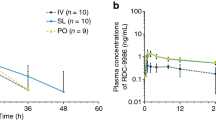Abstract
Purpose. Population pharmacokinetics of a fast release diclofenac wereassessed with special focus on pharmacodynamic implications.
Methods In a double blind four-way crossover study, 20 healthyvolunteers received orally 50 and 100 mg diclofenac-Na effervescent(“fast-release NSAID”), 50 mg diclofenac tablets (“control”), or placebo.Population pharmacokinetics of the fast release diclofenac wereassessed using a nonlinear mixed effects modeling approach(NON-MEM). Analgesic effects were investigated by means of anexperimental pain model based on both pain-ratings and cortical evoked potentialsafter specific stimulation of nasal nociceptors with short pulses ofgaseous CO2.
Results. Pharmacokinetics of fast release diclofenac were bestdescribed by a two-compartment population model, with an estimatedterminal half-life of 1.2 hours. Pharmacokinetics of diclofenac tabletswere highly variable and a population pharmacokinetic model couldnot be obtained. As an indication of an early onset of analgesic effects,100 mg fast release diclofenac but not the tablets significantly reducedthe amplitudes of pain-related evoked potentials at 30 min afteradministration.
Conclusions. Earlier drug absorption and lower pharmacokineticvariability of the fast-release formulation are likely to be preserved ina population.
Similar content being viewed by others
REFERENCES
M. Marchini, L. Tozzi, R. Bakshi, R. Pistai, and L. Fedele. Comparative efficacy of diclofenac dispersible 50 mg and ibuprofen 400 mg in patients with primary dysmenorrhea. A randomized, double-blind, within-patient, placebo-controlled study. Int. J. Clin. Pharmacol. Ther. 33:491–497 (1995).
M. Langemark and J. Olesen. Effervescent ASA versus solid ASA in the treatment of tension headache. A double-blind, placebo controlled study. Headache 27:90–95 (1987).
T. Hummel, O. Cramer, P. Mohammadian, G. Geisslinger, E. Pauli, and G. Kobal. Comparison of the antinociception produced by two oral formulations of ibuprofen: ibuprofen effervescent vs ibuprofen tablets. Eur. J. Clin. Pharmacol. 52:14 (1997).
K. H. Steen, F. Anton, P. W. Reeh, and H. O. Handwerker. Sensitization and selective excitation by protones of nociceptive nerve endings in rat skin, in vitro. Pflügers Arch. 415:R106 (1990).
G. Kobal, C. Hummel, B. Nuernberg, and K. Brune. Effects of pentazocine and acetylsalicylic acid on pain-rating, pain-related evoked potentials and vigilance in relationship to pharmacokinetic parameters. Agents Actions 29:342–359 (1990).
T. Hummel, H. G. Kraetsch, J. Lösch, M. Hepper, J. Liefhold, and G. Kobal. Comparison of the effects of dihydrocodeine and tramadol when administered either in the morning or in the evening. Chronobiol. Int. 12:62–72 (1994).
J. Lösch, W. Ditterich, T. Hummel, and G. Kobal. Antinociceptive effects of the kappa-opioid receptor agonist RP 60180 compared with pentazocine in an experimental human pain model. Clin. Neuropharmacol. 20:224–232 (1997).
J. Lösch, P. Mohammadian, T. Hummel, S. Florin, K. Brune, G. Geisslinger, et al. Effects of azapropazone on pain-related brain activity in human subjects. Br. J. Clin. Pharmacol. 40:545–552 (1995).
Y. M. el-Sayed, M. E. Abdel-Hameed, M. S. Suleiman, and N. M. Najib. A rapid and sensitive high-performance liquid chromatographic method for the determination of diclofenac sodium in serum and its use in pharmacokinetic studies. J. Pharm. Pharmacol. 40:727–729 (1988).
M. Gibaldi and D. Perrier. Pharmacokinetics. 2 ed.: Marcel Dekker, Inc., New York, 1982.
V. W. Steinijans and E. Diletti. Statistical analysis of bioavailability studies: parametric and nonparametric confidence intervals. Eur. J. Clin. Pharmacol. 24:127–136 (1983).
A. J. Boeckmann, L. B. Sheiner, and S. L. Beal. NONMEM user's guide. San Francisco: University of California San Francisco, 1994.
T. J. Hastie. Generalized additive models. Statistical models. London: Chapman & Hall, 1993.
C. F. Minto, T. W. Schnider, T. D. Egan, E. Youngs, H. J. Lemmens, P. L. Gambus, et al. Influence of age and gender on the pharmacokinetics and pharmacodynamics of remifentanil. I. Model development. Anesthesiology 86:10–23 (1997).
M. O. Karlsson and L. B. Sheiner. The importance of modeling interoccasion variability in population pharmacokinetic analyses. J. Pharmacokinet. Biopharm. 21:735–750 (1993).
G. Kobal. Pain-related electrical potentials of the human nasal mucosa eliceted by chemical stimulation. Pain 22:151–163 (1985).
H. O. Handwerker and G. Kobal. Psychophysiology of experimentally induced pain. Physiol. Rev. 73:639–671 (1993).
J. Stevens. Applied multivariate statistics for the social sciences. 3 ed. Mahwah, New Jersey: Lawrence Erlbaum Associates, Publishers, 1996.
L. B. Sheiner, D. R. Stanski, S. Vozeh, R. D. Miller, and J. Ham. Simultaneous modeling of pharmacokinetics and pharmacodynamics: application to d-tubocurarine. Clin. Pharmacol. Ther. 25:358–371 (1979).
N. H. Holford and L. B. Sheiner. Pharmacokinetic and pharmacodynamic modeling in vivo. CRC Crit. Rev. Bioeng. 5:273–322 (1981).
M. Mustofa, S. Suryawati, I. Dwiprahasto, and B. Santoso. The relative bioavailability of diclofenac with respect to time of administration. Br. J. Clin. Pharmacol. 32:246–247 (1991).
R. E. Small. Diclofenac sodium. Clin. Pharm. 8:545–558 (1989).
A. C. Chen, C. R. Chapman, and S. W. Harkins. Brain evoked potentials are functional correlates of induced pain in man. Pain 6:365–374 (1979).
M. Miyazaki, H. Shibasaki, M. Kanda, X. Xu, K. Shindo, M. Honda, et al. Generator mechanism of pain-related evoked potentials following CO2 laser stimulation of the hand: scalp topography and effect of predictive warning signal. J. Clin. Neurophysiol. 11:242–254 (1994).
J. E. Torres-Lopez, F. J. Lopez-Munoz, G. Castaneda-Hernandez, F. J. Flores-Murrieta, and V. Granados-Soto. Pharmacokinetic-pharmacodynamic modeling of the antinociceptive effect of diclofenac in the rat. J. Pharmacol. Exp. Ther. 282:685–690 (1997).
A. Suri, B. L. Grundy, and H. Derendorf. Pharmacokinetics and pharmacodynamics of enantiomers of ibuprofen and flurbiprofen after oral administration. Int. J. Clin. Pharmacol. Ther. 35:1–8 (1997).
J. R. DeAndrade, M. Maslanka, T. Maneatis, L. Bynum, and M. Burchmore. The use of ketorolac in the management of postoperative pain. Orthopedics 17:157–166 (1994).
E. M. Laska, A. Sunshine, I. Marrero, N. Olson, C. Siegel, and N. McCormick. The correlation between blood levels of ibuprofen and clinical analgesic response. Clin. Pharmacol. Ther. 40:1–7 (1986).
Author information
Authors and Affiliations
Rights and permissions
About this article
Cite this article
Lötsch, J., Kettenmann, B., Renner, B. et al. Population Pharmacokinetics of Fast Release Oral Diclofenac in Healthy Volunteers: Relation to Pharmacodynamics in an Experimental Pain Model. Pharm Res 17, 77–84 (2000). https://doi.org/10.1023/A:1007574710140
Issue Date:
DOI: https://doi.org/10.1023/A:1007574710140




